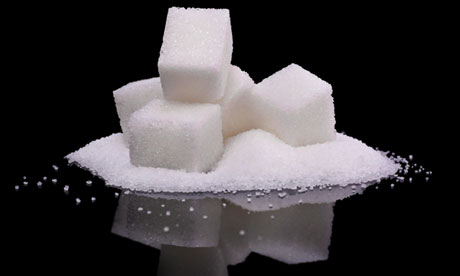Many people who sincerely desire t lose weight erroneously think that cutting out fat from the diet will help them attain their goal. Since their fat is the problem, then, getting fat out of the diet seems to be the logical solution.
Actually its not- witness all the failures to lose weight! It turns out that it is primarily the sugar in the diet that is the real cause of weight gain. No amount of dieting, exercise can overcome that reality. Only when you get the sugar out can normal weight occur.
Americans today are, as a whole, addicted to sugar, eating 40 times as much per day as a century ago.
The human body was never designed to handle that much sugar. Going from an average of 4 pounds a year to up to 160 pounds a year is just too much for the body to withstand and obesity and poor health are the outcomes.
Handle the sugar and you handle the weight problem and many chronic degenerative conditions such as diabetes, heart disease,weak immunity and all kinds of mood disorders, just to name a few. It has been estimated that over 150 diseases are directly linked to excess sugar consumption.
Sugar, not fat, exposed as deadly villain in obesity epidemic
It's addictive and toxic, like a drug, and we need to wean ourselves off it, says US doctor
Recipes for a dozen low-sugar treats
Recipes for a dozen low-sugar treats

Dr Robert Lustig's book Fat Chance: The Bitter Truth About Sugar has caused a backlash from the food industry, which, he says, wants to 'paint me as this zealot'. Photograph: Alamy
Sugar – given to children by adults, lacing our breakfast cereals and a major part of our fizzy drinks – is the real villain in the obesity epidemic, and not fat as people used to think, according to a leading US doctor who is taking on governments and the food industry.
Dr Robert Lustig, who was this month in London and Oxford for a series of talks about his research, likens sugar to controlled drugs. Cocaine and heroin are deadly because they are addictive and toxic – and so is sugar, he says. "We need to wean ourselves off. We need to de-sweeten our lives. We need to make sugar a treat, not a diet staple," he said.
"The food industry has made it into a diet staple because they know when they do you buy more. This is their hook. If some unscrupulous cereal manufacturer went out and laced your breakfast cereal with morphine to get you to buy more, what would you think of that? They do it with sugar instead."
Lustig's book, Fat Chance: The Bitter Truth About Sugar has made waves in America and has now been published in the UK by 4th Estate. As a paediatrician who specialises in treating overweight children in San Francisco, he has spent 16 years studying the effects of sugar on the central nervous system, metabolism and disease. His conclusion is that the rivers of Coca-Cola and Pepsi consumed by young people today have as much to do with obesity as the mountains of burgers.
That does not mean burgers are OK. "The play I'm making is not sugar per se, the play I'm making is insulin," he says. Foodstuffs that raise insulin levels in the body too high are the problem. He blames insulin for 75% to 80% of all obesity. Insulin is the hormone, he says, which causes energy to be stored in fat cells. Sugar energy is the most egregious of those, but there are three other categories: trans fats (which are on the way out), alcohol (which children do not drink) and dietary amino acids.
These amino acids are found in corn-fed American beef. "In grass-fed beef, like in Argentina, there are no problems," he said. "And that's why the Argentinians are doing fine. The Argentinians have a meat-based diet … I love their meat. It is red, it's not marbled, it's a little tougher to cut but it's very tasty. And it's grass-fed. That's what cows are supposed to eat – grass.
"We [in the US] feed them corn and the reason is twofold – one, we don't have enough land and, two, when you feed them corn they fatten up. It usually takes 18 months to get a cow from birth to slaughter. Today it takes six weeks and you get all that marbling in the meat. That's muscle insulin resistance. That animal has the same disease we do, it's just that we slaughter them before they get sick."
But his bigger message is that cheap sugar is endangering lives. It has been added to your diet, "kids have access" to it, and it is there in all sorts of foods that don't need it, he says. When high-fat foods were blamed for making us overweight, manufacturers tumbled over each other to produce low-fat products. But to make them palatable, they added sugar, causing much greater problems.
Cutting calories is not the answer because "a calorie is not a calorie". The effect of a calorie in sugar is different from the effect of a calorie in lean grass-fed beef. And added sugar is often disguised in food labelling under carbohydrates and myriad different names, from glucose to diastatic malt and dextrose. Fructose – contained in many different types of sugar – is the biggest problem, and high-fructose corn syrup, used extensively by food manufacturers in the US, is the main source of it.
Lustig says he has been under attack from the food industry, but claims they have not managed to fault the science. "The food industry wants to misinterpret because they want to discredit me. They want to paint me as this zealot. They want to paint me as somebody who doesn't have the science. But we do," he says.
Evidence of dietary effects on the body is very hard to collect. People habitually lie in food diaries or forget what they ate. Randomised controlled trials are impossible because everyone reverts to a more normal eating pattern after a couple of months. But his sugar argument is more than hypothesis, he says, citing a recent study in the open journal Plos One, of which he was one of the authors. It found that in countries where people had greater access to sugar, there were higher levels of diabetes. Rates of diabetes went up by about 1.1% for every 150 kcal of sugar available for each person each day – about the amount in a can of Coke. Critics argued sugar availability was not the same as sugar consumed, but Lustig and his colleagues say it is the closest approximation they could get.
That study was aimed at the World Health Organisation although he believes it is a conflicted organisation.
But so is the US government, he says. "Government has tied its wagon to the food industry because, at least in America, 6% of our exports are food. That includes the legislative and executive branches. So the White House is in bed with the food industry and Congress apologises for the food industry."
Michelle Obama appeared to be onside when she launched her Let's Move initiative in February 2010 with a speech to the Grocery Manufacturers Association of America. "She took it straight to them and said, 'You're the problem. You're the solution.' She hasn't said it since. Now it's all about exercise.
"Far be it from me to bad-mouth somebody who wants to do the right thing. But I'm telling you right now she's been muzzled. No question of it." In his book he tells of a private conversation with the White House chef, who he claims told him the administration agreed with him but did not want a fight with the food industry.
Some areas of the food industry have appeared to be willing to change. PepsiCo's chief executive officer, Indra Nooyi, who is from India which has a serious diabetes epidemic, has been trying to steer the company towards healthier products. But it has lost money and she is said to be having problems with the board. "So here's a woman who is trying to do the right thing and can't," he says.
Court action may be the way to go, he says, suggesting challenging the safety of fructose added to food, and food labelling that fails to tell you what has been added and what has been taken out. Fruit juice is not so healthy, he says, because all the fibre that allows the natural sugars to be processed without being stored as fat has been removed. Eat the fruit, he says, don't drink the juice. Lustig is taking a master's at the University of California Hastings college of law, in order to be a better expert witness and strategist.
It is not a case of eradicating sugar from the diet, just getting it down to levels that are not toxic, he says. The American Heart Association in 2009 published a statement, of which Lustig was a co-author, saying Americans consumed 22 teaspoons of it a day. That needs to come down to six for women and nine for men.
"That's a reduction by two thirds to three quarters. Is that zero? No. But that's a big reduction. That gets us below our toxic threshold. Our livers have a capacity to metabolise some fructose, they just can't metabolise the glut that we've been exposed to by the food industry. And so the goal is to get sugar out of foods that don't need it, like salad dressing, like bread, like barbecue sauce." There is a simple way to do it. "Eat real food."
Does he keep off the sweet stuff himself? "As much as I can. I don't go out of my way. It finds me but I don't find it. Caffeine on the other hand …"
Lustig's food advice
• Oranges. Eat the fruit, don't drink the juice. Fruit juice in cartons has had all the fibre squeezed out of it, making its sugars more dangerous.
• Beef. Beef from grass-fed cattle as in Argentina is fine, but not from corn-fed cattle as in the US.
• Coca-Cola, Pepsi and other sweetened beverages. These deliver sugar but with no nutritional added value. Water and milk are the best drinks, especially for children.
• Bread. Watch out for added sugar in foods where you would not expect it.
• Alcohol. Just like sugar, it pushes up the body's insulin levels, which tells the liver to store energy in fat cells. Alcohol is a recognised cause of fatty liver disease.
• Home-baked cookies and cakes. If you must eat them, bake them yourself with one third less sugar than the recipe says. Lustig says they even taste better that way.












